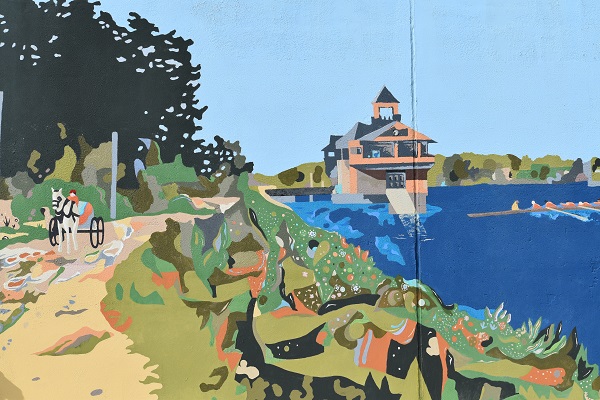KINSHIPS-RIVERS-BRIDGES
By Don Doucette

Our colorful building mural depicts a tranquil scene of the Seekonk River as a northern geographic appendage of Narragansett Bay – this artwork appears on a commercial building on the East Side of Providence and is made possible through the courtesy of the Koffler Group.
Two companion watersheds feed the tidal Seekonk River, these watersheds include the Blackstone River Watershed and the Ten Mile River Watershed.
Native Americans camped along these shores for thousands of years harvesting marine resources.
Roger Williams first crossed the Seekonk River waters to found Providence and later, hand carried across the first Rhode Island Charter granted to Mister Williams in England. Roger Williams crossed the Atlantic Ocean with a writ of safe passage guaranteeing his unmolested transit through Boston – his concern that the Puritan leadership of Boston would detain him for persecution reasons.
Before founding Providence, Roger Williams cut short an attempt to settle along the southern shore of the Ten Mile River which we presently refer to as Omega Pond, a former tidal cove portion of the Seekonk River. An Industrial Era granite dam blocked the tidal action into that cove to create the freshwater impoundment found there presently.
The personal homestead estate of Moses Brown overlooked the Seekonk River.
The first rail line between India Point in Providence and Canton Junction ran parallel to the Seekonk River as that rail bed still exists today through Rumford Village, the fist settlement site of Rehoboth.
The Seekonk River was a busy commercial and passenger shipping lane during the ninetieth century leading to the ports of Phillipsdale and Pawtucket. Ship loads of raw sulphur and bone entered the Port of Providence for transfer along the Seekonk River corridor and utilized as raw material to manufacture chemical compounds produced by the Rumford Works.
The Brown University Rowing Club began its rowing tradition upon Seekonk River waters.
The original alignment of U.S. Route Six crossed the Seekonk River over the former Red Bridge, a ferry crossing site once operated by Moses Brown.
Those of us who are more seasoned citizens remember the Red Bridge when summer heat expanded metal and jammed the bridge works in the open position.
A rich history exists along the Seekonk River. Municipal and state boundaries aside, we who reside in the local watershed domain mentioned herewith are all citizens of the Narragansett Basin drainage through common water connections and similar cultural kinships.
Don Doucette
“Ten Mile River Rambles”
Friends of the Ten Mile
Citizen of the Ten Mile River Watershed
Photo credit: Don Doucette
